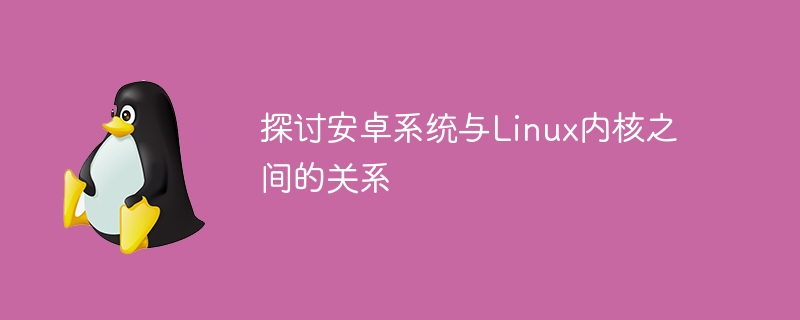

The Android system and the Linux kernel are two closely related entities, and the relationship between them is close and complex. In the Android system, the Linux kernel plays an important role, providing underlying hardware drivers and system call support for the Android system. This article will explore the relationship between the Android system and the Linux kernel, how they interact and work together, and provide some specific code examples.
Android is a mobile operating system developed based on the Linux kernel and is mainly used for mobile devices such as smartphones and tablets. The Linux kernel is the underlying core running on the device hardware. It is responsible for managing the hardware resources of the device and providing system calls and other functions. Based on the Linux kernel, the Android system has built a complete set of application frameworks and user interfaces to provide users with a comprehensive mobile application experience.
The relationship between the Android system and the Linux kernel can be described with a simple metaphor: the Linux kernel is the foundation of a house, and the Android system is the house built on this foundation. Without a solid foundation, a house cannot exist stably; similarly, the Android system cannot run properly without the support of the Linux kernel.
In the Android system, interaction with the Linux kernel is mainly achieved through system calls and drivers. System calls are a mechanism for communication between applications and the kernel. Applications can request the kernel to perform specific operations through system calls. Here is a simple sample code that demonstrates how to use system calls in an Android application to get the current system time:
import java.util.Date;
public class SystemTimeExample {
public static void main(String[] args) {
long currentTimestamp = System.currentTimeMillis();
Date currentDate = new Date(currentTimestamp);
System.out.println("Current system time: " + currentDate);
}
}In the above code, via System.currentTimeMillis()Method to get the current system timestamp, then convert the timestamp into a date object, and print out the current system time. This process involves the encapsulation of system calls by the Java language, but in fact the underlying system calls are completed through the Linux kernel.
In addition to system calls, drivers are also an important bridge between the Android system and the Linux kernel. The driver is responsible for interacting with the device hardware, passing user space requests to the kernel space, and then the kernel space operates the hardware for data transmission and other operations. Common drivers in Android systems include image drivers, memory management drivers, input device drivers, etc.
The following is a simple driver example code that demonstrates how to write a simple character device driver in the Linux kernel for passing data to user space:
#include <linux/module.h>
#include <linux/fs.h>
#include <linux/uaccess.h>
#define DEVICE_NAME "example"
#define BUFFER_SIZE 1024
char buffer[BUFFER_SIZE] = "Hello, World!
";
int pos = 0;
static ssize_t driver_read(struct file *file, char *buf, size_t count, loff_t *ppos) {
int bytes_read = 0;
while(count && buffer[pos] != '') {
put_user(buffer[pos], buf);
pos++;
bytes_read++;
count--;
buf++;
}
return bytes_read;
}
static struct file_operations fops = {
.owner = THIS_MODULE,
.read = driver_read,
};
static int __init driver_init(void) {
register_chrdev(0, DEVICE_NAME, &fops);
return 0;
}
static void __exit driver_exit(void) {
unregister_chrdev(0, DEVICE_NAME);
}
module_init(driver_init);
module_exit(driver_exit);
MODULE_LICENSE("GPL");
MODULE_AUTHOR("Your Name");In the above code , we defined a character device driver named example, which contains a buffer for storing data and implemented the driver_read function for passing data to user space. This driver can be compiled and run in the Linux kernel and creates a character device named example in the system. Users can obtain data by reading this device.
To sum up, the relationship between the Android system and the Linux kernel is a close cooperation. The Android system is built on the basis of the Linux kernel and interacts with the kernel through system calls and drivers to jointly provide users with An all-in-one mobile app experience. Through specific code examples, we can gain a deeper understanding of the working principles and collaboration mechanisms between them, and thus better understand the inner workings of mobile device operating systems.
The above is the detailed content of Explore the relationship between the Android system and the Linux kernel. For more information, please follow other related articles on the PHP Chinese website!
 Which company does Android system belong to?
Which company does Android system belong to?
 The difference between Hongmeng system and Android system
The difference between Hongmeng system and Android system
 Can data between Hongmeng system and Android system be interoperable?
Can data between Hongmeng system and Android system be interoperable?
 What happens when software crashes?
What happens when software crashes?
 The role of barcodes
The role of barcodes
 Introduction to hard disk performance indicators
Introduction to hard disk performance indicators
 How to write batch script bat
How to write batch script bat
 what does os mean
what does os mean




